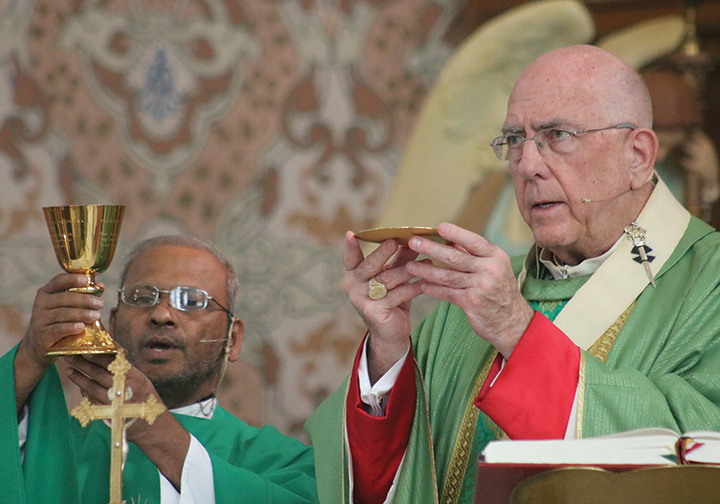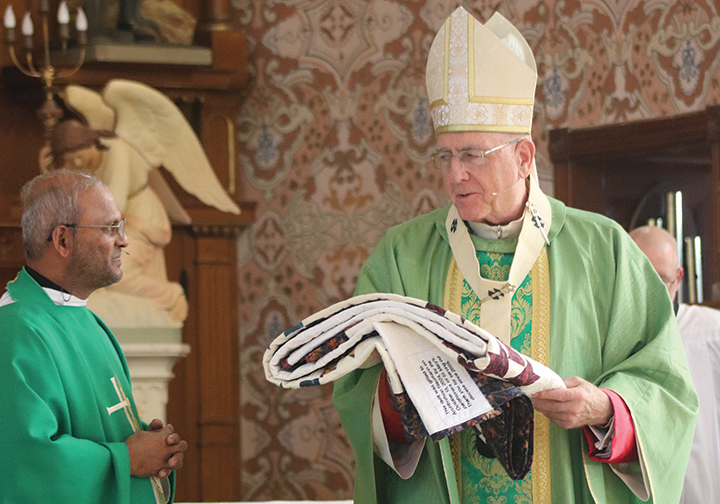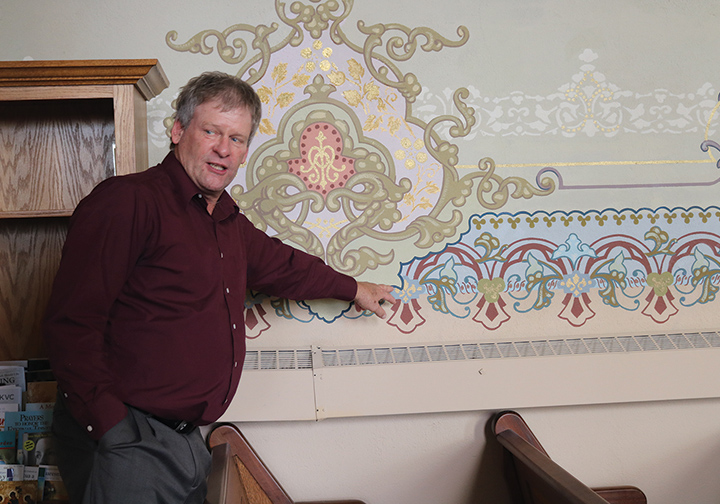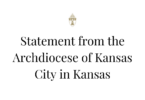
by Marc and Julie Anderson
mjanderson@theleaven.org
ST. BENEDICT — It’s been called the “jewel of the archdiocese.”
But even jewels need a little polishing every now and then in order to bring out their sparkle.
Such is the case with St. Mary Church in St. Benedict which reopened on Oct. 13, after being closed for several months for a much-needed restoration and renovation effort.
Archbishop Joseph F. Naumann, assisted by pastor Father Reginald Saldanha and former pastor Father Jim Shaughnessy, celebrated a 10:15 a.m. Mass at which he blessed the church interior. Deacon Jody Madden, currently assigned to St. Benedict Parish in Atchison and Rural Outreach Ministry, served as master of ceremonies.

The renovation effort focused on things the parish’s 140 families don’t necessarily notice — that is, unless they’re not operating correctly — the electrical and sound systems. The restoration efforts focused on the hand-painted stenciling on the walls, installing new flooring to replace what was installed in 1959 and refurbishing the original pews. Efforts began late in 2023 with the launch of a capital campaign in the amount of $500,000.
Completed in 1894, the church’s exterior is similar in construction to many others built in the state in the same time frame. Yet every square inch of the interior is covered in some form of ornamentation, whether hand-painted stencils on the walls, the 14 oil paintings or the stained-glass windows. The artwork led the Kansas Sample Foundation to name the church as one of the eight wonders of Kansas art.
In his homily, Archbishop Naumann expressed his wonder and amazement at the beauty of the church, saying those who built the church obviously had great love for God.
“Buildings are important,” he said. “They reflect the culture’s priorities, and the fact that your ancestors would build this magnificent structure — living much more simply — is a living testimony that God was first for them and a sign for generations to come. And your care for this church — your efforts to preserve it and to beautify it to keep it a living church — is also a testimony of your faith.”
“I salute you on your care of this church,” he added, “the sacrifices — the personal sacrifices so many people have made to make this restoration possible.”

Near the end of Mass, Father Saldanha expressed gratitude to numerous people, including Father Shaughnessy for filling in for him while he returned home to India for vacation; the deacon who served as emcee; and “all those involved” — whether it be the professionals who installed the flooring, members of the Altar Society who cleaned the church, the various council and committee members, or the many volunteers who gave of their time.
“Most importantly, I would like to express my heartfelt gratitude for the parishioners here in St. Benedict Church and also others from out of parish for all of their generous contributions,” he said. “For when this idea of restoration was brought up, you all got on board, each in your own way, in the renovation of this church. As [the] archbishop said in his homily, it shows your love of this parish, for this church and is a testament to your faith.”
One group that jumped on board was a crew of six to eight parishioners who used 50 gallons of paint, spending 1,700 hours of their time — much of it on rented scaffolding — to paint the walls and restore the stenciling throughout the church — which had only been restored one other time in the early1980s.

“It is difficult to convey how important the elaborate painting of St. Mary’s Church is. It has artistic and historical significance,” said Elmer Ronnebaum, whose grandparents were among the first parishioners.
“In the last 200 years, Catholic and mainline Protestant churches were not considered complete until they were elaborately painted,” he said. “Detailed painting was the standard. The goal was not to inspire admiration for the artwork itself. Instead, the painted churches were the work of the common working man, the immigrant believer who lived the Gospel in the hard knocks of life and knew it to be true.”
“This was very personal art,” he continued, “without it being about the people executing it. The traditional common-man artist focused on the timeless story of Christ and his church. The art is an act of love, a kind of prayer. Here, the goal is to inspire devotion, connection and conviction in the faith. It is to convey the wonder and sacredness of the story, right here and always, as it does in the lives of the saints.”
Parishioner Lillian Engelken feels it does exactly that — the artwork leading her gaze to the most important feature of the church, that of the tabernacle.
“You know who’s there,” she said.
“It just kind of draws you, the whole atmosphere of the church,” she concluded. “When you see it all, it just makes you feel closer to God. You can’t really think of anything else.”






